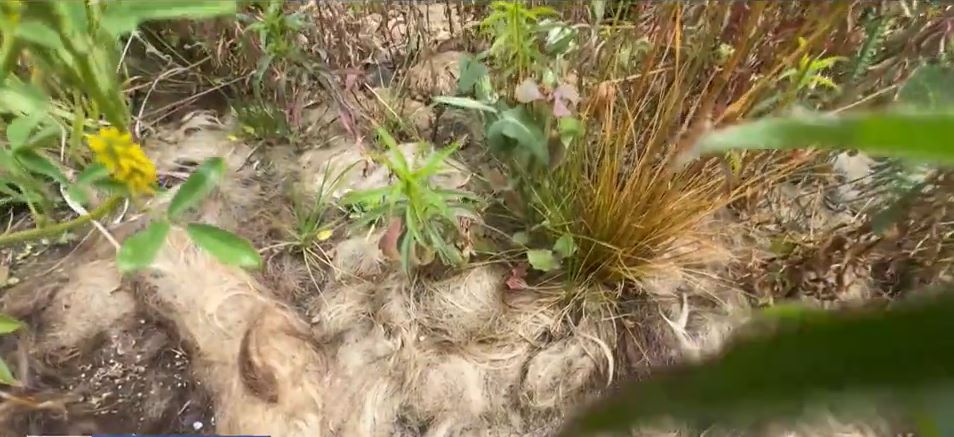Bay Area researchers test how human hair can improve soil

Researchers at UC Berkeley and ecologists at the Presidio in San Francisco are digging into the question: can human hair supercharge the soil on our farms and fields and help us fight the impacts of climate change?
By Anne Makovec, Molly McCrea
Click here for updates on this story
SAN FRANCISCO (KPIX) — Curly, wavy or straight, long or short, we tend to do a lot with our hair. It grows about half an inch a month. Most of us just cut it off, and throw it away, or should we?
Researchers at UC Berkeley and ecologists at the Presidio in San Francisco are digging into the question: can human hair supercharge the soil on our farms and fields and help us fight the impacts of climate change?
Our first stop is in the Department of Environmental Sciences at Cal, where CBS News Bay Area met up with ecosystem ecologist Dr. Whendee Silver and visiting scholar Dr. Tibisay Perez. The scientists are studying the biogeochemical effects of climate change, human impacts on the environment and possible ways to mitigate the effects.
One strategy: grow more plants in order to pull that climate warming CO2 out of the atmosphere and sequester it in the soil.
A way to do that may actually involve using human hair.
“If it turns out that this is the case, it would be very exciting,” noted Silver.
The scientists collected untreated hair from a local beauty salon. Strands were then ground up and then put in tiny bottles.
Silver showed us the bottles. “We take a very small amount… just .2 grams and we then distribute that into the soil,” she explained.
The soil that the researchers are using is poor and not very fertile. They collected it from Marin County.
In the lab, undergraduate Kai Nittenberg added small amounts of the hair into jarred soil samples. Eight weeks later, the researchers collected some promising preliminary results.
“We began to see evidence that the hair was beginning to breakdown,” said Silver.
“When we started to see the changes in the hair amended soils, we have higher nutrient content,” added Perez.
The scientists observed that the hair was acting like a slow-release organic fertilizer and changing the bad soil into good soil. They said one possible explanation is that the hair contains nitrogen.
“Hair breaks down slowly and that nitrogen is packaged in the hair in such a way that it’s released slowly,” said Silver.
In the jars, the researchers also measured nitrous oxide, a potent greenhouse gas. But they quickly told CBS News Bay Area that in this case, they held no concerns.
“In our experiment, there were no plants. We did this in the absence of plants to simplify the experiment. But if the plants had been there, there’s a good probability, they would have been able to capture that nitrogen,” noted Silver.
Once the plants access the slow-release nitrogen, it could result in a slow, prolonged growth. That phenomenon is what appears to be happening with other hair experiments now underway at The Presidio in San Francisco.
CBS News Bay Area went to an open field at the National Park, and met up with Lewis Stringer, Associate Director of Natural Resources at the Presidio Trust. The ecologist showed us where the experiments were located and the growth is quite impressive.
“We just scattered it over these tiny plants that were barely growing. They could barely make it and that has resulted in this beautiful meadow of bunch grasses, and this wouldn’t have happened if had not out that hair down,” said Stringer.
He walked us around some rocky areas, pointing out lush plots teeming with native plants.
“It’s amazing. I would never have considered that hair could be so productive for helping us restore these very harsh soils,” said the park ecologist.
In a few experiments, park researchers cordoned off plots of land and seeded it all with the same amount of seeds to produce native plants. The only difference was how these plots were treated. They received either straw mulch, hair, fertilizer or nothing at all.
Our eyeballs could not believe it: the lushest plots were the ones treated with hair.
“There’s much more growth in those plots of hair where there is with just fertilizer or compost,” explained Stringer.
The experiments at the Presidio and UC Berkeley were both funded by Matter of Trust, a nonprofit based in San Francisco that collects donated hair.
Lisa Gautier is the co-founder and CEO of the group. Gautier showed CBS News Bay Area show the hair compost adheres to the soil, become incorporated into the ground.
She also told us how hair contains other useful nutrients that is supercharging the rich soil. Gautier explained that for millions of years, Mother Nature had the right idea when animals shed their fur, birds molted feathers, and humanity shed hair, it fell to the forest floor, soil took it in, and used it in a cycle she calls “the Quiet Fiber Cycle.”
“This is a renewable resource growing right in front of our eyes,” said Gautier.
“Whether I’m taking the hair off of my cat or cutting my kids hair it always goes into my garden now and helps fertilize it,” noted Stringer.
“I’m starting to think about what else can hair do?” smiled Silver.
And that can make every day a good hair day.
The Presidio is about to analyze the data from its field studies and Silver told us her results are preliminary and that the next study will involve plants.
If you are inspired to toss your hair into garden or plants, a word of caution: stay away from long hair. The long strands can tangle up birds and other small critters and harm them.
Please note: This content carries a strict local market embargo. If you share the same market as the contributor of this article, you may not use it on any platform.